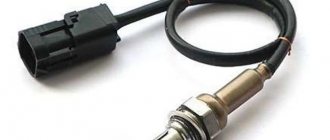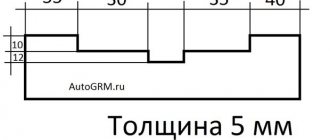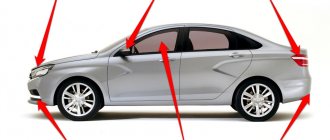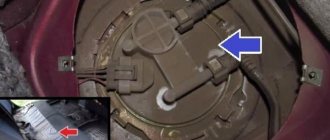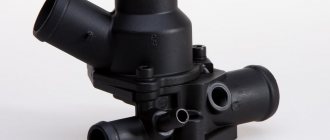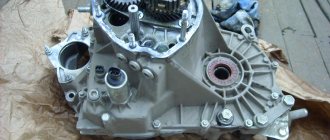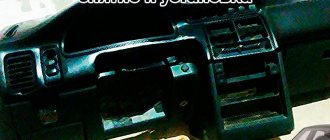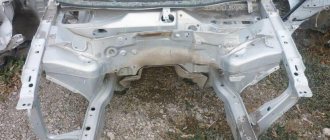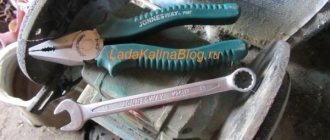About the belt
Kalina uses a toothed belt that rotates not only the camshafts, but also the coolant pump. The belt length depends on the engine model. In 16-valve engines, due to the presence of two camshafts, the belt is significantly longer than in 8-valve models with one camshaft.
1 - Crankshaft gear; 2 - Water pump gear; 3 - Tension roller; 4 — Camshaft gear mark strip; 5 - Camshaft gear; 6 - Belt; A-B - Camshaft marks; C-D - Crankshaft marks;
The 16-valve engine belt has 136 teeth with a tooth width of 25.4 mm.
The 8-valve engine belt has 111 teeth with a tooth width of 19 mm.
Checking the belt
You only need to check the condition of the unit when the engine is cold. The top drive cover is removed for inspection. It is better to also dismantle the tank with glass washing liquid, as it may well interfere. In order to remove the drive cover you will have to unscrew 5 screws; finding them will not be difficult. The cover should be removed by lifting its upper edge. You will also have to remove the front wheel on the right. Now we take the head at 17 and turn the crankshaft clockwise with it.
Now we inspect the timing belt. It is important to know that there should be no cracks, folds or peeling on its teeth. The wear should not be to such an extent that the threads are already visible. There should be no cracks or signs of delamination at the ends. If such defects are found, this is a clear signal that it is time to replace the belt. The reason for replacing the belt may be the discovery of oil traces on it. Most likely, oil was dripping from the coolant pump. So, when installing a new belt, you need to inspect it and, if necessary, repair it.
The belt tension must meet the technical requirements. To check it, rotate the crankshaft clockwise until the marks on the pulley teeth align with the cutouts on the drive cover. The belt tension will be considered normal if the cutout of the outer disc coincides with the protrusion of the inner bushing.
The belt tension can be adjusted if it is not so loose. To do this, it is necessary to loosen the bolt securing the roller, which is used for tensioning. To tighten the belt, the roller that serves to tension it is turned counterclockwise; to loosen it, it is turned clockwise. The outer disk has grooves into which the “horned” key is inserted. This key is universal and is used when repairing all VAZs with front-wheel drive.
Using this key, the belt is tensioned to the desired level. It should be borne in mind that the belt should not be overtightened, otherwise this may cause malfunction of both the belt and the guide rollers. But you can’t under-tighten the belt either. If this happens, the belt will also fail ahead of schedule. Ultimately, this can lead to the pistons contacting the valves, which will lead to breakdown of the mechanism and, as a result, to expensive repairs. That is why only optimal belt tension is permissible. The belt must be changed if the defects mentioned above are found. And now directly about its replacement.
Consequences of a broken belt
A design feature of the 16-valve engines on the Lada Kalina is that the valves bend when the belt breaks. This defect is caused by the absence of grooves in the pistons, but the absence of grooves is not due to a mistake by AvtoVAZ engineers, it is necessary to increase the compression ratio in the combustion chamber. Therefore, a broken belt in a 16-valve engine foreshadows a major and expensive repair in 99% of cases.
Bent valves due to broken timing belt
To prevent the belt from breaking, it is recommended to monitor it every 20,000 km and check it.
This problem is not observed on 8-valve engines.
Replacing the timing belt without special tools
The method can be used if there is no need to change the rollers.
Procedure
:
- Cut off half of the old timing belt with a utility knife.
- Remove half of the old timing belt.
- We put a new timing belt on the crankshaft pulleys.
- We cut the second half of the old timing belt and remove it.
- Pull the new timing belt onto the crankshaft pulleys until the end.
Where can I buy
: Timing belt kits at low prices are available in our online store (Timing belt category).
The best timing belt for Lada Kalina
Choosing the best belt for Kalina is quite difficult, since when purchasing you can run into counterfeits of famous brands such as Gates and Dayco. It is these two brands that are most often counterfeited, since they are bought much more often than others. It is recommended to purchase products only from trusted stores.
From the factory, the standard belt on all Lada models is installed by Gates; AvtoVAZ gives its preference to it.
The table below shows timing belts for Lada Kalina with article numbers.
| Brand | vendor code |
| Gates | K015631XS |
| Gates | K015521XS |
| Dayco | KTB842 |
| Contitech | CT1137K1 |
Step-by-step instruction
- Loosen the locknut of the generator belt tensioning mechanism. Using a 10-mm socket, unscrew the tensioning mechanism pin and remove the drive belt, checking for wear, cracks and traces of oil. We check the tension roller when rotating; it should not make any extraneous noise. To replace the generator belt on Kalina, you will have to remove the engine mount, first dismantling the protection and jacking up the power unit.
- Remove the upper protective cover of the timing belt by unscrewing the four bolts (hexagon 5).
Set the top dead center
- We turn the crankshaft by the pulley mounting bolt clockwise until the mark on the camshaft pulley and the timing belt guard coincide.
Be sure to rotate the crankshaft clockwise, otherwise increased force will be applied to the timing parts.
Mark on the camshaft.
- We unscrew the bolt of the auxiliary drive pulley (in common parlance - the crankshaft). We block the wheels with stops, tighten the handbrake, engage fifth gear and, with a slight movement of the wrench and a one and a half meter pipe extension, unscrew this bolt. Repair books also advise opening the plug on the clutch housing and aligning the marks on the flywheel, but this is an absolutely useless procedure. Firstly, the flywheel could simply be misplaced according to the marks, for example when replacing the crankshaft oil seal, and secondly, in order to provide access to this mark, it is necessary to remove the air filter housing with the corrugation. And why do we need these extra operations?
Important! Never remove the crankshaft bolt with the starter.
- Next, use the same 5mm hexagon to unscrew the bolts securing the lower timing belt cover and remove it.
- Remove the protective washer.
- The marks on the crankshaft timing belt should be aligned with the oil pump housing.
Crankshaft mark.
- Praise be to the designers of AvtoVAZ, finally rollers with a tension indicator appeared on the Lada Kalina 2 engines, now you don’t need to pull it on by eye and check the tension by twisting the belt, not even thirty years have passed since the invention of such a design. We unscrew the tension roller bolt and dismantle the latter; we also remove the old timing belt. The photo shows that the belt has stretched out because the tension marks have diverged; when checking the condition of the timing belt, if you see this, you will just need to tighten it.
Replacing the pump
- To replace the pump, we need to remove the camshaft pulley, and also unscrew a few bolts of the inner casing and remove it. If signs of wear are found on the camshaft pulley, it is better to replace it.
- Three bolts out and the pump replaced (hexagon 5). The green arrow indicates the hole for the tension roller bolt.
Pump mount.
- Having replaced the water pump, we proceed to the next stage.
How often to change the timing belt
Drivers with a calm driving style and in the absence of factors that complicate the operation of the gas distribution mechanism drive can change the timing belt on a schedule. That is, if the operating instructions indicate that new rollers and a belt need to be installed after 60 thousand kilometers, we do so. When assessing the safe life of the timing drive, the automaker refers to average loads and additionally provides a small margin for periodic exposure to adverse factors.
However, there are a number of circumstances that have a great influence on how often the timing belt needs to be changed.
- Driving exclusively in city mode, especially with frequent stops in traffic jams. Here it would not be a mistake to change the timing belt 20–30% of the mileage earlier than the automaker recommends. In the vast majority of cases, passenger cars do not have an hour meter. And mileage is a very relative indicator. When driving on the highway, the engine can run 3–5 times less than during city use.
- Oiling the cavity under the timing drive. In this case, we change the belt along with the shaft seals immediately after detecting the problem. If the chain needs lubrication, then oil is detrimental to the belt. Despite the fact that most manufacturers today make belts from oil-resistant materials, the risk of sudden breakage due to oil ingress increases.
- Replacing any component that requires dismantling the timing drive. In this case, experienced motorists immediately change the belt, since its cost is usually low, and the cost of work sometimes exceeds the price of the roller and belt combined.
- Noticeable damage to the belt: cracks, delamination of rubber in the longitudinal and transverse plane, the appearance of cord threads, damage to the teeth. Noticed something like this? The timing belt needs to be changed immediately.
- Belt skipping on gears with valve timing offset. Regardless of the condition of the belt and its “age”, we replace it with a new one. Slippage on gear teeth is associated with large loads on the cord. And externally, a whole belt may have fatal damage to the reinforcing frame.
Basic faults
There can only be three main faults with the timing belt:
- violation of the integrity of the structure;
- under- or overtension;
- break.
In the first case, the belt may simply delaminate, as evidenced by dangling reinforcing threads. In addition, belt teeth are often cut off. These problems are the result of mechanical damage, improper adjustment:
- camshaft stars;
- crankshaft pulley;
- toothed roller;
- pumps;
- tension roller.
The tension roller is designed to tension the belt by rotating around its own eccentric axis. If it is not adjusted correctly, the belt may be too tight, which will sooner or later render it unusable. The same problem will occur if the belt is loose.
The most unpleasant surprise, especially on the road, is a broken timing belt. In this case, the engine will immediately stall, and it will be possible to start it only by installing a new belt.
Tools for replacing the timing belt on Lada Priora
Let's start with the fact that to replace the timing belt on a Priora 16 valves you will have to stock up on a very specific set of tools. This is definitely a set of hexagons, a set of torx bits, and a set with a small 1/4-inch ratchet will not work, we’ll tell you why later. In addition, you will need a device for tensioning the roller, but the usual one from 2114 will not work, you need a slightly wider one. If you have enough strength, you can tighten the roller simply by leaning against it with a mounting tool; many people do this.
It is also necessary to clarify whether there are 16 valves on the Priora with or without air conditioning. If yes, then the belt needs to be longer. The belt is officially supplied with a length of 1125. However, most owners say that it is better to use 1115. This is due to the following. The fact is that initially the 16-valve 21127 was designed without air conditioning. Everything was simple. The pump is driven by the timing belt, the alternator belt is no longer responsible for anything. In general, it couldn’t be simpler. Crankshaft and generator with tensioner, without rollers.
The designers were faced with an almost unimaginable task - to install an air conditioning compressor, which they accomplished. Yes, not perfect, but we did it. And therefore, two additional pulleys appeared here - a compressor and a tension roller. The problem is that previously the contact patch of the generator pulley was about 120 degrees. After the introduction of the new scheme, it is approximately 30 degrees, because the tension roller pulls the belt and does not press it against the pulleys, as was the case, for example, on Kalina. By the way, many car owners later began installing these same brackets with a tensioner in order to dismantle this circuit.
